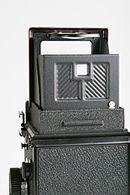Light shaft finder
A light shaft finder is a technical device in cameras - mostly medium or large format cameras .
With SLR cameras , the image is projected onto a focusing screen ( focusing screen) to enable the photographer to assess and focus the subject . The focusing screen is located on the top of the camera, pivoted by 90 degrees with respect to the optical axis of the lens.
With a light shaft finder it is possible to look directly at the focusing screen from above. The light shaft also darkens the bright ambient light and thus helps to better recognize the image. The most common form of the light shaft is a foldable construction that, when erected, forms four side walls. Often a magnifying glass can be folded out of one of the side walls to enlarge the image on the focusing screen or a viewfinder (with or without exposure metering) with a pentaprism (roof prism) and a view from behind can be placed on the light shaft.
With medium format cameras, the front of the light shaft finder can often be folded back; The horizontal view is traditionally referred to as a sports viewfinder (which has the real background that the reversed image and the position of the light shaft viewfinder is hardly suitable for fast-moving subjects).
The image appears upright in the shaft viewfinder, but reversed.
This type of viewfinder is offered by some professional 35mm cameras and many medium format cameras . From a photographic point of view, the light shaft finder offers several advantages :
- By looking into the camera from above, it is easier to take pictures from a lower position (e.g. for portrait photography ).
- Many people feel less annoyed by taking pictures if the photographer looks upside down into the light shaft instead of “aiming” the camera directly at the model.
- For longer periods of observation, for example in nature photography, the use of a light shaft finder for the eyes is much more relaxing.
- Shooting close to the ground ( frog's eye view ) or overhead (over an obstacle) are naturally easier to make with a LS, but an angle viewfinder on the prism viewfinder has roughly the same effect.
Cons :
- Portrait format shots are almost impossible freehand, since the mirror-inverted motion sequences can hardly be mastered, so the light shaft viewfinder is particularly common with 6 × 6 medium format cameras that do not have a portrait format.
- The avant-garde Russian photographer and artist Alexander Michailowitsch Rodtschenko (1891–1956) polemicized in the 1920s against the " belly button perspective ", which the light shaft seeker almost regularly enforces, and did everything in the design of his photos to counteract this.
In contrast to the classic light shaft viewfinder , however, with most 35mm single lens reflex cameras there is a viewfinder instead of a light shaft , which enables a view of the focusing screen via a built-in penta prism or a corresponding mirror system. However, this only allows you to look into the viewfinder from the back of the camera. To (be able to use or around the camera useful, for. Example, on a copy stand) a glimpse of the top of this seeker permit, are Angle Finder available.
High-quality KB system cameras offer interchangeable viewfinders so that light shaft viewfinders can also be used here.
Edixa Reflex-B (35mm SLR),
with closed light shaft viewfinderEdixa Reflex-B,
without viewfinder unit
(= interchangeable viewfinder )







